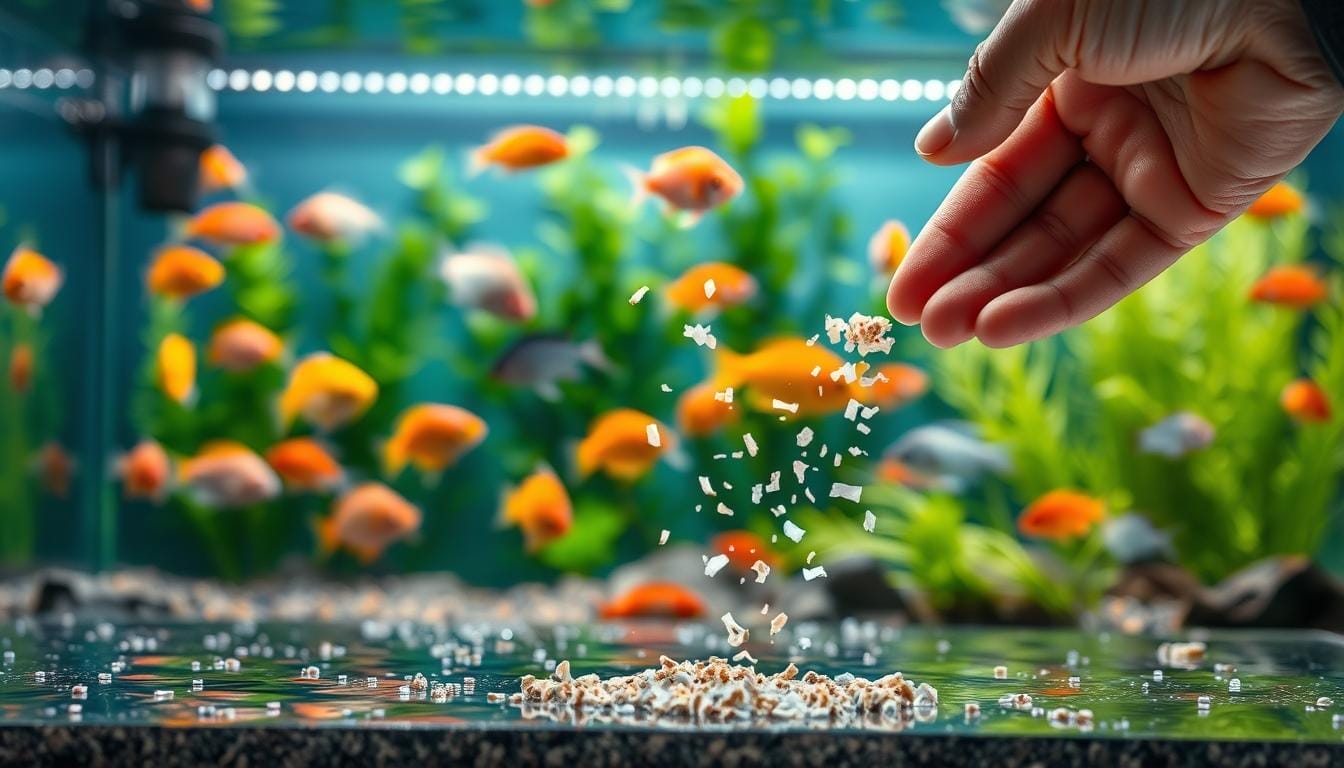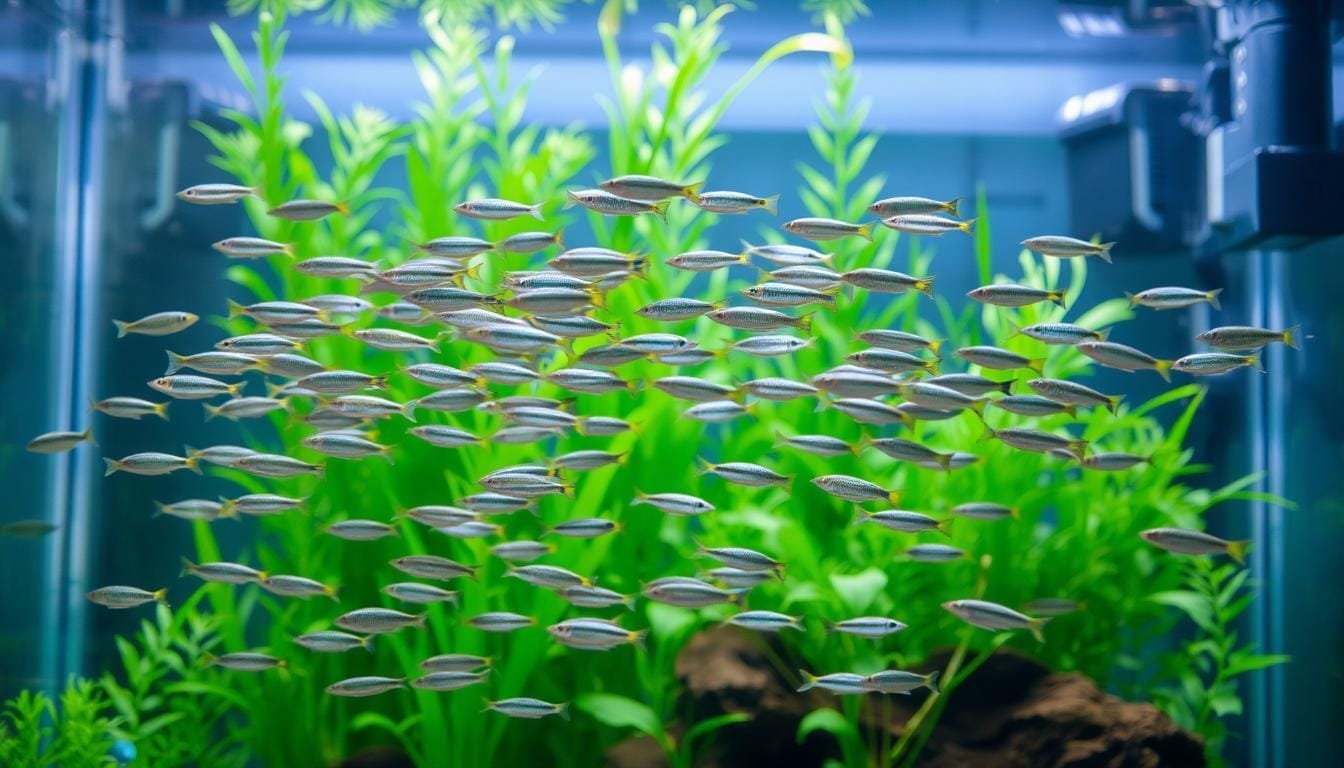
Schooling Fish Species: A Guide for Aquarium Enthusiasts

Did you know a single fish swimming alone experiences 3x more stress than when surrounded by its own kind? This simple truth explains why group-dwelling creatures have become the stars of thriving freshwater setups. Their synchronized movements and vibrant hues can turn any tank into a living masterpiece.
These social swimmers aren’t just pretty to watch—they’ve perfected their group dynamics over millennia. When kept in communities of six or more, they display bolder colors and explore their environment with confidence. This natural behavior creates endless fascination for hobbyists while maintaining harmony in your aquatic world.
The best choices for community tanks combine peacefulness with adaptability. Look for varieties that stay mid-sized—large enough to avoid becoming snacks, yet small enough to prevent bullying. Their curiosity about surroundings sparks constant activity, making your aquarium feel alive from every angle.
By understanding their needs, you’ll create more than just a container of water. You’ll craft a balanced ecosystem where every finned resident thrives. Let’s explore how these captivating creatures can elevate your tank from ordinary to extraordinary while simplifying maintenance for lasting enjoyment.
Understanding Schooling and Shoaling Behavior
Ever watched aquatic creatures move like a living ribbon through your tank? This mesmerizing underwater ballet stems from two distinct social behaviors. Knowing these patterns helps you create environments where your aquatic friends truly flourish.
Coordinated Movement Masters
Some aquatic species perform precise, synchronized dances. They stick together in tight formations, turning on a dime as if sharing one mind. Their secret? Instant reactions to neighbors’ movements—no practice needed. This instinct helps them survive in the wild by confusing predators.
Social But Independent Swimmers
Other types prefer casual gatherings. While they enjoy company, they explore separately while staying loosely connected. You’ll spot them nibbling algae in different tank areas, yet always keeping companions in sight. Both styles provide security, but require different observation approaches.
Notice how your tank’s inhabitants interact. Tight-knit groups need open swimming space, while looser clusters appreciate plants for casual meetups. Recognizing these natural tendencies helps you design spaces that reduce stress and boost confidence in your underwater community.
Key Characteristics of a Peaceful Community Tank
Imagine your aquarium as a bustling neighborhood where every resident feels safe and valued. The secret to this harmony lies in three core principles: proper group sizes, balanced interactions, and thoughtful species pairings.

Ideal Group Dynamics for Healthy Tanks
Start with six companions as the foundation for most social aquatic life. Larger groups reduce anxiety, letting their true personalities—and colors—shine. You’ll notice bolder exploration and playful chases once they feel secure in numbers.
Size matters more than you might think. Choose mid-sized varieties that won’t intimidate smaller tankmates or become targets themselves. This balance prevents bullying while maintaining visual interest throughout your setup.
- Match energy levels between species to avoid stress
- Combine bottom-dwellers with mid-water swimmers
- Select adaptable creatures that handle parameter changes
Watch how your aquatic community interacts during feeding time. Peaceful groups share space without aggression, creating fluid movement patterns. Pair surface-skimmers with plant-loving varieties to utilize every tank zone effectively.
Remember: Overcrowding kills the vibe. Follow the “one inch per gallon” rule while ensuring each species group meets its minimum size requirement. Your reward? A living mosaic where every participant thrives.
Essential Schooling Fish Species for Your Community Tank
Your aquarium transforms into a living kaleidoscope when filled with these vibrant performers. Each brings unique energy while working together to create underwater harmony. Let’s meet the standouts that make community setups shine.

Neon Tetras & Rummy Nose Showstoppers
Neon Tetras dazzle with electric blue backs and fiery red stripes. At just 1.5 inches, these easy-care swimmers adapt to various water conditions. Their peaceful nature makes them perfect neighbors in busy setups.
Rummy Nose Tetras wear natural health monitors – their crimson faces fade when water quality drops. Watch their striped tails flash during synchronized swims. Keep groups of eight+ for confident displays.
Celestial Jewels & Ruby Beauties
Celestial Pearl Danios resemble swimming constellations with starry blue spots and orange fins. Though tiny (1 inch), groups of ten+ create mesmerizing patterns. They thrive in planted tanks with gentle water flow.
Cherry Barbs mature into scarlet showpieces, especially males competing for attention. Their calm demeanor balances active tankmates. Pair with dark substrate to make colors pop.
More Captivating Choices
Consider these crowd-pleasers for diverse setups:
- Harlequin Rasboras – Copper-bodied with triangular markings
- White Cloud Minnows – Silver streaks with red accents
- Zebra Danios – Dynamic striped swimmers
Match your tank size and experience level when choosing. Each option brings distinct personality while maintaining group cohesion. Proper care ensures years of aquatic enjoyment.
Tips for Creating a Successful Community Tank Setup
What separates a good aquatic environment from a great one? Thoughtful design that supports both beauty and natural behaviors. Your setup choices directly impact how your aquatic friends interact and thrive.
Selecting the Right Tank Size and Layout
Start with 10 gallons minimum for small groups. Larger communities need 20+ gallons to prevent cramped swimming. Leave 40% open space for active movement while using plants and décor to create sheltered zones.

Tall plants like Amazon Sword work wonders. They create vertical pathways without crowding surface areas. Pair them with smooth rocks or driftwood to break sightlines and reduce territorial disputes.
Incorporating Live Plants and Aquatic Décor
Java Fern and Anubias are beginner-friendly champions. Their broad leaves offer perfect hideouts and grazing surfaces. Floating Hornwort adds overhead coverage that eases stress during feeding times.
Arrange elements to mimic natural habitats. Create depth by placing taller plants at the back and shorter varieties up front. This layered approach gives every resident their preferred space while keeping your fish aquarium visually balanced.
Expert Advice on Fish Feeding and Care
Proper nutrition and water management form the backbone of a thriving aquatic community. When done right, these elements help your colorful swimmers stay vibrant while promoting harmony in shared spaces.
Feeding Strategies for Peaceful Groups
Most active swimmers thrive on quality flakes or micro-pellets. Offer small portions twice daily—only what they finish in two minutes. This prevents leftover food from clouding your tank.
Variety keeps colors bright and energy high. Try frozen brine shrimp or bloodworms as weekly treats. For bottom-dwellers like Bristlenose Plecos, sink algae wafers or blanched zucchini slices after lights-out. Discover more about balanced aquatic diets to meet all nutritional needs.

Maintaining Ideal Aquatic Conditions
Weekly 25% water changes remove waste without shocking residents. Always treat new water to neutralize chlorine first. Test ammonia and nitrate levels every 7-10 days—stable water conditions prevent stress-related issues.
Surface agitation from filters or air stones oxygenates the tank. This supports active swimmers while helping beneficial bacteria thrive. Keep temperatures consistent; sudden shifts weaken immune systems.
With these easy care practices, your aquatic friends will get along beautifully. Watch for lively group movements and healthy appetites—they’re the best signs your community fish feel at home.
Recognizing and Preventing Stress in Schooling Fish
Your aquarium’s harmony depends on spotting silent distress signals before they escalate. Like canaries in coal mines, these social creatures reveal environmental issues through subtle behavioral shifts. Catching these cues early helps you restore balance quickly.
Decoding the Silent Language of Distress
Watch for fading vibrancy in your aquatic friends. The Rummy Nose Tetra’s crimson face acts like a mood ring—bright red means contentment, while pale hues signal trouble. Isolated swimmers or frantic darting often mean anxiety spikes.
Groups that scatter instead of moving as one need immediate attention. Frequent position swaps within tight clusters suggest perceived threats. This natural defense mechanism works best in proper numbers—understanding fish psychology helps prevent these issues.
Loners often turn aggressive or listless. Maintain groups of six+ to support natural behaviors. Pair this with stable water conditions and hiding spots to rebuild confidence. Your reward? A vibrant, synchronized display where every member thrives.
FAQ
How many fish should I keep in a schooling group?
Aim for groups of 6-8 minimum to reduce stress and encourage natural behaviors. Larger tanks can accommodate bigger groups for species like neon tetras or rummy nose tetras, creating stunning visual displays.
Can I mix different types of schooling fish in one tank?
Yes! Combine peaceful species like celestial pearl danios and cherry barbs if they share similar water requirements. Ensure adequate space and hiding spots to prevent territorial behavior.
Do these fish need special plants or decorations?
A> Live plants like java fern or anubias help replicate natural habitats and reduce stress. Open swimming areas paired with driftwood or rock formations create a balanced environment for active groups.
What water parameters work best for community tanks?
Most schooling species thrive in 72-78°F with neutral pH (6.5-7.5). Always research specific needs – for example, neon tetras prefer softer water compared to harlequin rasboras.
How do I spot stressed fish in my aquarium?
Watch for faded colors, rapid gill movement, or isolated individuals. Clamped fins and reduced appetite often indicate poor water quality or incompatible tank mates needing immediate attention.
What foods keep schooling species healthy?
Offer varied diets: high-quality flakes for daily feeding, frozen brine shrimp for protein boosts, and algae wafers for bottom-dwellers. Small, frequent meals mimic their natural grazing habits.





